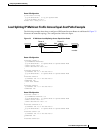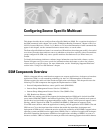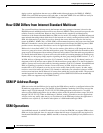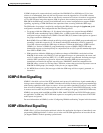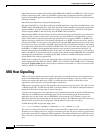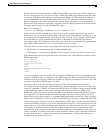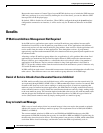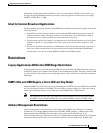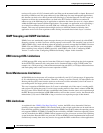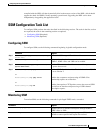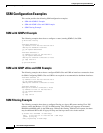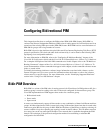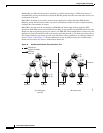
Configuring Source Specific Multicast
Restrictions
IPC-465
Cisco IOS IP Configuration Guide
deployment. Another factor that contributes to the ease of installation of SSM is the fact that it can
leverage preexisting PIM-SM networks and requires only the upgrade of last hop routers to support
IGMPv3, IGMP v3lite, or URD.
Ideal for Internet Broadcast Applications
The three benefits previously described make SSM ideal for Internet broadcast-style applications for the
following reasons:
• The ability to provide Internet broadcast services through SSM without the need for unique IP
multicast addresses allows content providers to easily offer their service (IP multicast address
allocation has been a serious problem for content providers in the past).
• The prevention against DoS attacks is an important factor for Internet broadcast services because,
with their exposure to a large number of receivers, they are the most common targets for such
attacks.
• The ease of installation and operation of SSM makes it ideal for network operators, especially in
those cases where content needs to be forwarded between multiple independent PIM domains
(because there is no need to manage MSDP for SSM between PIM domains).
Restrictions
Legacy Applications Within the SSM Range Restrictions
Existing applications in a network predating SSM will not work within the SSM range unless they are
modified to support (S, G) channel subscriptions or are enabled through URD. Therefore, enabling SSM
in a network may cause problems for existing applications if they use addresses within the designated
SSM range.
IGMP v3lite and URD Require a Cisco IOS Last Hop Router
SSM and IGMPv3 are solutions that are being standardized in the IETF. However, IGMP v3lite and URD
are Cisco-developed solutions. For IGMP v3lite and URD to operate properly for a host, the last hop
router toward that host must be a Cisco IOS router with IGMP v3lite or URD enabled.
Note This limitation does not apply to an application using the HSIL if the host has kernel support
for IGMPv3, because then the HSIL will use the kernel IGMPv3 instead of IGMP v3lite.
Address Management Restrictions
Address management is still necessary to some degree when SSM is used with Layer 2 switching
mechanisms. Cisco Group Management Protocol (CGMP), IGMP snooping, or Router-Port Group
Management Protocol (RGMP) currently support only group-specific filtering, not (S, G)
channel-specific filtering. If different receivers in a switched network request different (S, G) channels
sharing the same group, then they will not benefit from these existing mechanisms. Instead, both



